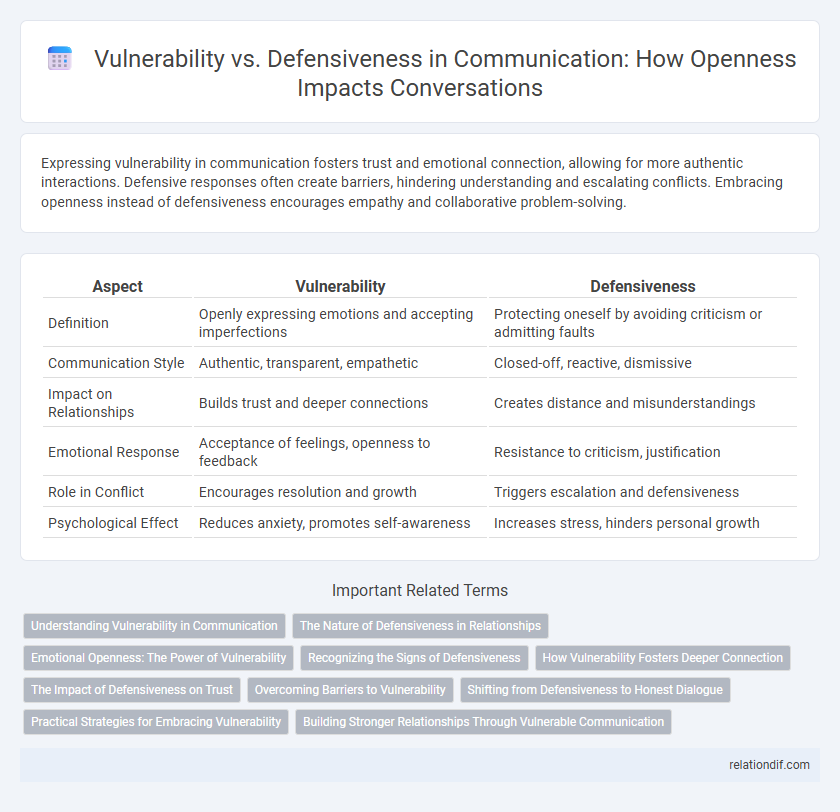Expressing vulnerability in communication fosters trust and emotional connection, allowing for more authentic interactions. Defensive responses often create barriers, hindering understanding and escalating conflicts. Embracing openness instead of defensiveness encourages empathy and collaborative problem-solving.
Table of Comparison
| Aspect | Vulnerability | Defensiveness |
|---|---|---|
| Definition | Openly expressing emotions and accepting imperfections | Protecting oneself by avoiding criticism or admitting faults |
| Communication Style | Authentic, transparent, empathetic | Closed-off, reactive, dismissive |
| Impact on Relationships | Builds trust and deeper connections | Creates distance and misunderstandings |
| Emotional Response | Acceptance of feelings, openness to feedback | Resistance to criticism, justification |
| Role in Conflict | Encourages resolution and growth | Triggers escalation and defensiveness |
| Psychological Effect | Reduces anxiety, promotes self-awareness | Increases stress, hinders personal growth |
Understanding Vulnerability in Communication
Expressing vulnerability in communication fosters trust and deepens emotional connections by showing authentic feelings and openness. Recognizing vulnerability allows individuals to share uncertainties without fear of judgment, promoting empathy and mutual understanding. Embracing vulnerability reduces defensiveness, enabling clearer, more honest dialogue that strengthens relationships.
The Nature of Defensiveness in Relationships
Defensiveness in relationships often manifests as a protective response to perceived criticism, shielding individuals from emotional exposure but hindering open communication. This behavior can escalate conflicts and reduce trust, as partners may interpret defensiveness as rejection or unwillingness to engage. Understanding the neurobiological basis of defensiveness reveals it as an instinctive survival mechanism, yet recognizing its impact allows couples to foster vulnerability, enhancing empathy and intimacy.
Emotional Openness: The Power of Vulnerability
Emotional openness fosters authentic connections by allowing individuals to express vulnerability without fear of judgment, enhancing trust and empathy in communication. Embracing vulnerability reduces defensiveness, enabling more genuine dialogue and promoting mutual understanding. Research in emotional intelligence highlights that vulnerability strengthens relationships by encouraging honest exchanges and emotional resilience.
Recognizing the Signs of Defensiveness
Recognizing the signs of defensiveness in communication involves observing behaviors such as closed body language, interrupting, and dismissive responses. These signs often indicate an attempt to protect oneself from perceived criticism or emotional exposure. Understanding these cues enables more empathetic and effective dialogue by addressing underlying fears rather than escalating conflict.
How Vulnerability Fosters Deeper Connection
Vulnerability fosters deeper connection by encouraging honest and open communication, allowing individuals to express genuine emotions without fear of judgment. This openness builds trust and empathy, creating a safe space for mutual understanding and emotional intimacy. Embracing vulnerability reduces defensiveness, leading to more meaningful and authentic relationships in both personal and professional settings.
The Impact of Defensiveness on Trust
Defensiveness in communication creates barriers that hinder open, honest dialogue, eroding trust between parties. When individuals respond defensively, it signals an unwillingness to listen or empathize, fostering suspicion and insecurity. Persistent defensiveness damages relational bonds, reducing collaboration and effective problem-solving over time.
Overcoming Barriers to Vulnerability
Overcoming barriers to vulnerability requires recognizing defensiveness as a protective response that limits authentic communication and emotional connection. Practicing active listening and expressing empathy fosters a safe environment where individuals feel encouraged to share openly without fear of judgment. Building trust through consistent, honest dialogue reduces defensive reactions and enhances relational intimacy.
Shifting from Defensiveness to Honest Dialogue
Shifting from defensiveness to honest dialogue requires embracing vulnerability as a strength in communication. Vulnerability fosters openness, allowing individuals to express emotions and concerns authentically, which promotes trust and deeper understanding. This transformation enhances conflict resolution by replacing reactive barriers with empathetic listening and genuine connection.
Practical Strategies for Embracing Vulnerability
Embracing vulnerability in communication requires practical strategies such as active listening, expressing emotions honestly, and maintaining openness to feedback. Practicing vulnerability fosters trust and deeper connections by reducing defensiveness and encouraging authentic dialogue. Implementing techniques like pausing before responding and using "I" statements helps create a safe environment for transparent conversations.
Building Stronger Relationships Through Vulnerable Communication
Vulnerable communication fosters trust and deepens emotional connections by encouraging openness and authenticity, essential for building stronger relationships. Embracing vulnerability reduces defensiveness, allowing individuals to express feelings and needs without fear of judgment or rejection. This approach enhances mutual understanding and empathy, creating a foundation for resilient and meaningful interpersonal bonds.
Vulnerability vs Defensiveness Infographic

 relationdif.com
relationdif.com